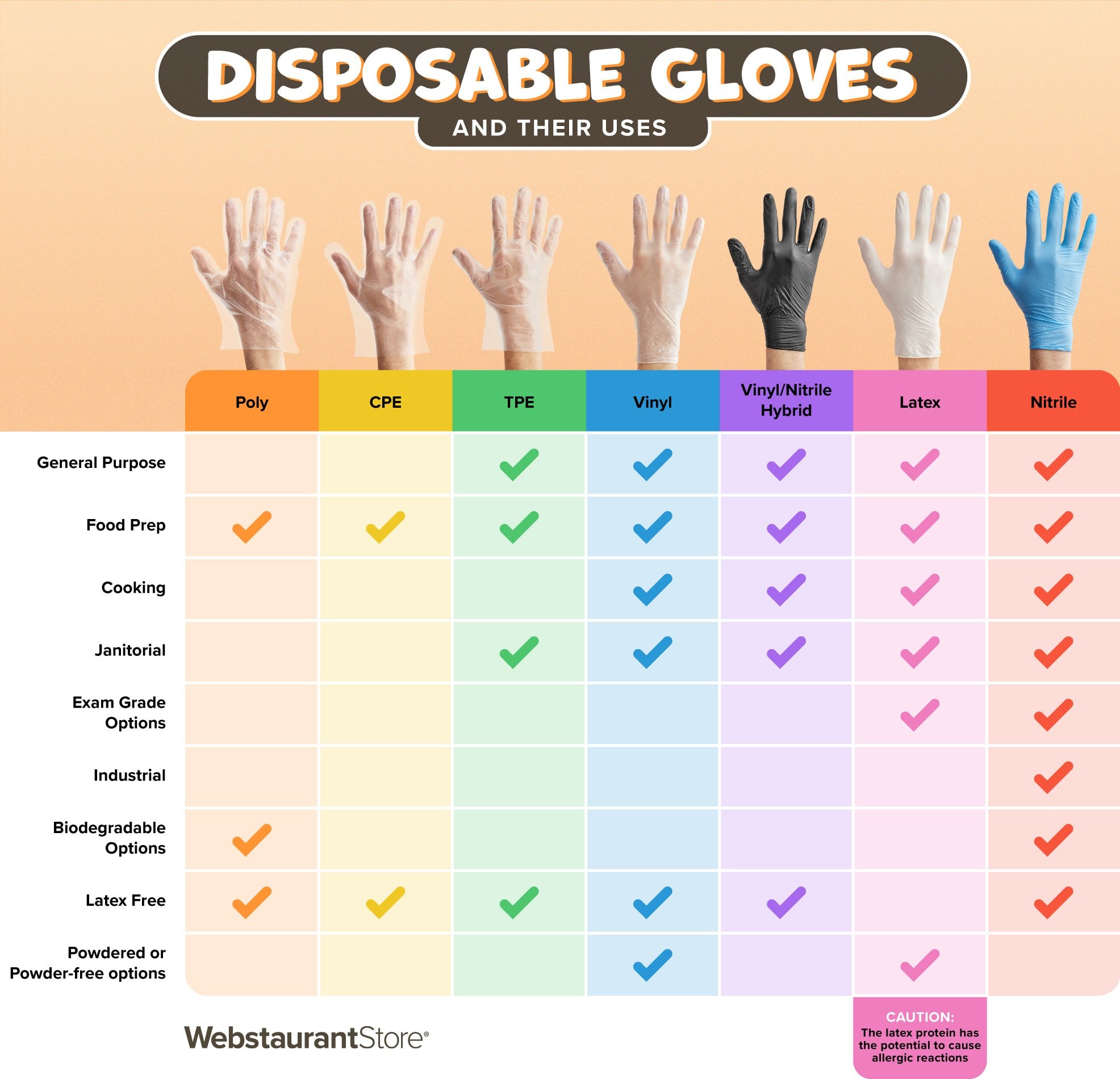
Types of Disposable Gloves
Disposable gloves are an important part of maintaining a successful food safety program for any foodservice establishment. There are many different types of single-use gloves available, so which ones are right for you? We'll cover the different types of disposable gloves and explain their important features to help you find the best gloves for your commercial kitchen.
Shop All Disposable Gloves
Food Grade Gloves
When it comes to handling food, there are many types of food safe disposable gloves on the market. Before you choose the right single-use glove, keep these considerations in mind:
What Are Food Safe Gloves?
All the gloves on our list are available in food-grade options, which means they are rated for safe food handling.Powdered vs Powder-Free:
Powdered gloves contain a coating of corn starch inside the glove. This makes it easy to slide the glove on and off but also presents a contamination issue if the powder leaves a residue on equipment and food. Currently, powdered gloves are banned for medical-grade use. Many recommend only using powder-free gloves for foodservice to eliminate the risk that cornstarch powder will contaminate food.Is Latex Safe?
Latex gloves have benefits, but they aren't safe for everyone. Those with a latex allergy can experience a serious reaction when exposed to latex. Check your state and local jurisdictions for specific legislation related to the use of latex gloves before using these in your business.Best Disposable Gloves
Learn about the most popular types of disposable gloves and what makes each type unique. Some gloves are better for light-duty use while others are more durable. In certain applications, a tight-fitting glove is preferable, but a loose fit can be beneficial when gloves are frequently removed. We'll cover the types of single-use gloves and their features below:

1. Nitrile Gloves
Disposable nitrile gloves are made from nitrile rubber, a synthetic material that provides superior resistance to chemicals and oils. These flexible gloves are puncture-resistant, making them ideal for tough industrial and janitorial jobs. You'll see black nitrile gloves used frequently in hair salons and tattoo shops, but they're also a great option for foodservice.
Nitrile gloves provide a snug fit with tactile sensitivity, which makes them comfortable to wear for long periods without irritation. They also have a long shelf-life, so these gloves will maintain their integrity over time.
Are Nitrile Gloves Food Safe? Yes
Do Nitrile Gloves Contain Latex? No
Are Nitrile Gloves Powder-Free? Yes
Best Applications for Nitrile Gloves: General purpose, food prep, cooking, janitorial, industrial, exam-grade options

2. Latex Gloves
For many years, latex gloves were considered the best option for single-use gloves thanks to their flexibility and strength. They conform tightly to the hand, providing tactile sensitivity that's ideal for handling small objects. The downside of latex is the potential to cause allergic reactions, which becomes a safety issue for guests and employees who are exposed to latex.
Latex gloves are now banned in Arizona, California, Connecticut, Hawaii, Massachusetts, Ohio, Oregon, and Rhode Island. Illinois also has a ban in place, but they offer a concession for foodservice businesses unable to source non-latex gloves. Prominent signage must be in place to alert customers that latex gloves are used in the operation.
Are Latex Gloves Food Safe? Yes
Are Latex Gloves Powder-Free? Powder-free options are available
Best Applications for Latex Gloves: General purpose, food prep, cooking, janitorial, exam-grade options (except where banned)
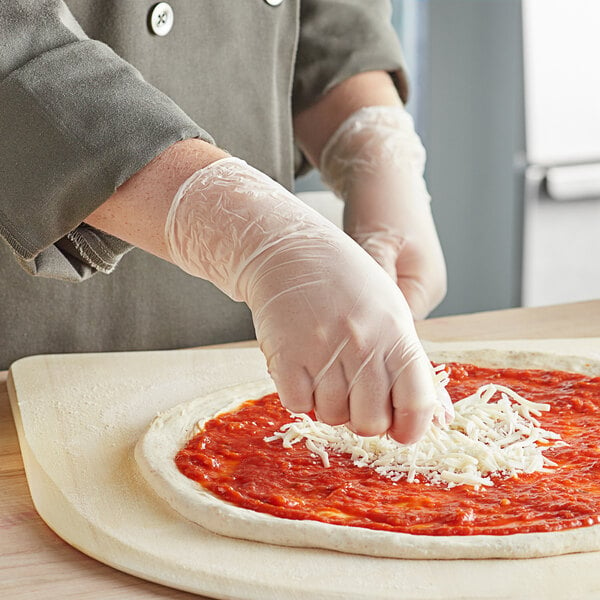
3. Vinyl Gloves
Vinyl gloves are a cost-effective alternative to nitrile or latex gloves. They provide a safe level of protection at a more affordable price, which is essential when buying in bulk. Vinyl is also durable and tear-resistant, reducing the risk of torn gloves.
You can find vinyl gloves offered in a range of thicknesses that are rated for different applications. Thicker vinyl gloves are suitable for medical and exam purposes. Powder-free options are the best choice for food prep.
Are Vinyl Gloves Food Safe? Yes
Do Vinyl Gloves Contain Latex? No
Are Vinyl Gloves Powder-Free? There are powder-free options available
Best Applications for Vinyl Gloves: General purpose, food prep, cooking, janitorial

4. Poly Gloves
Poly gloves are made from polyethylene plastic, a thinner material compared to nitrile, vinyl, and latex. This isn't necessarily a bad thing, it just makes poly gloves more suitable for light-duty tasks. You won't get the same level of tear resistance with poly, but you get a thin, lightweight glove that is easy to take off quickly.
Use polyethylene gloves for food prep tasks when gloves need to be changed often and you don't need chemical resistance. Poly gloves are also one of the most economical disposable gloves on our list.
Are Poly Gloves Food Safe? Yes
Do Poly Gloves Contain Latex? No
Are Poly Gloves Powder-Free? Yes
Best Applications for Poly Gloves: Food prep only

5. Hybrid Gloves
Hybrid gloves are made with vinyl and nitrile. The benefit of combining these two materials is a glove with the durability of nitrile at a more affordable price. These gloves are smoother and more flexible than vinyl and not as opaque as nitrile.
Choose vinyl/nitrile hybrid gloves to get the best of both worlds. Nitrile gloves are very popular, but they are also one of the most expensive options. Hybrid gloves make a great alternative.
Are Hybrid Gloves Food Safe? Yes
Do Hybrid Gloves Contain Latex? No
Are Hybrid Gloves Powder-Free? Yes
Best Applications for Hybrid Gloves: General purpose, food prep, cooking, janitorial
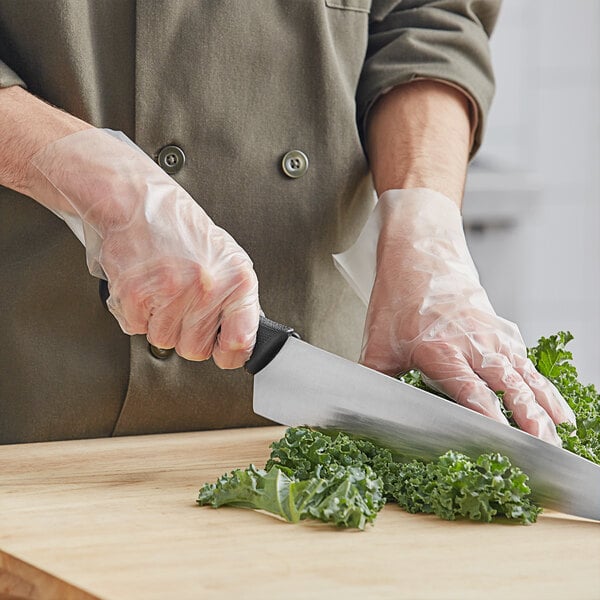
6. CPE Gloves
CPE is a type of polyethylene with enhanced durability. Gloves made with CPE have all the same benefits as poly gloves, with greater flexibility and strength. They're affordable, lightweight, and easy to remove after food prep tasks.
Just like disposable poly gloves, CPE gloves are best for light-duty tasks like prep work and food handling.
Are CPE Gloves Food Safe? Yes
Do CPE Gloves Contain Latex? No
Are CPE Gloves Powder-Free? Yes
Best Applications for CPE Gloves: Food prep only
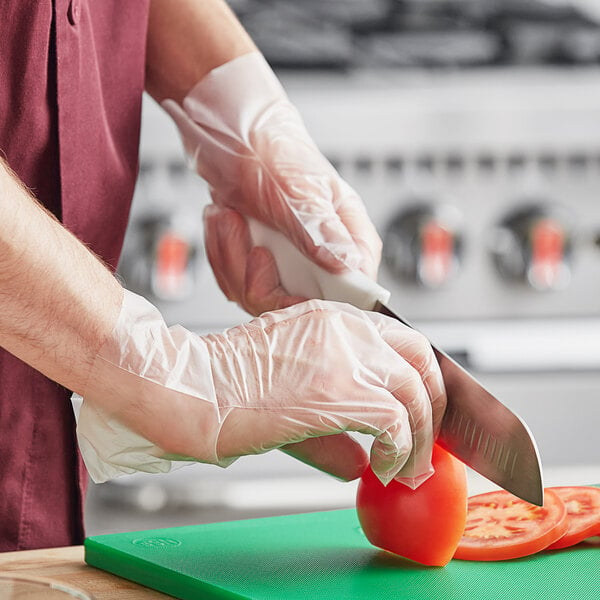
7. TPE Gloves
TPE stands for thermoplastic elastomer, a material that creates a smooth, flexible single-use glove. Gloves made with TPE are lightweight and comfortable like poly gloves but provide elasticity similar to vinyl gloves.
Choose TPE gloves for a more affordable option that flexes with the hand as it moves. Unlike regular poly gloves, TPE gloves can also be used for light cleaning tasks.
Are TPE Gloves Food Safe? Yes
Do TPE Gloves Contain Latex? No
Are TPE Gloves Powder-Free? Yes
Best Applications for TPE Gloves: General purpose, food prep, light janitorial
Related Resources
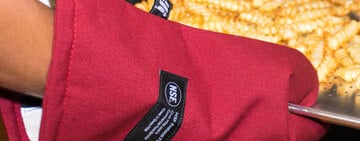
Hand Safety Guide
Hand injuries are the second most frequent injury in the restaurant industry after slips, trips, and falls. OSHA estimates that hand injuries cost the foodservice industry around $300 million a year in workers' compensation and lost work time! Think about the cost of medical care, food waste from contamination, prep work that's interrupted when others stop to help, and the overall distraction to other employees and guests. Such injuries can be limited by equipping your workers with the proper gloves and educating them so that they get used, instead of the closest towel. Our gloves are broken down into three categories: oven mitts and gloves, dishwashing and heavy duty gloves, and cut resistant gloves. Shop All Gloves
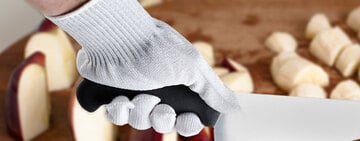
Types of Cut Resistant Gloves
Do your business's cut resistant gloves make the cut? Hand cuts and wounds are preventable accidents in the workplace, yet they account for a hefty percentage of injuries and lost employee time in the United States. Protecting employees' hands in the foodservice industry should be a high priority, but choosing the right cut resistant glove for your work environment isn't the easiest task. Slices, cuts, abrasions and punctures are all common workplace injuries, especially in the foodservice industry. But did you know these types of accidents account for almost 30% of lost time and productivity, and almost 80% of these injuries involve workers' hands? It's important to protect yourself and your employees with cut resistant gloves in order to

Hair Restraints for Foodservice
Hair is a physical contaminant that can fall into food, so foodservice establishments must require hair restraints to prevent food contamination and possible health code violations . This guide will go over the different types of hair coverings for foodservice and food safety hair rules to ensure your employees follow a proper dress code in your restaurant . Shop All Hair Restraints
- Topics 1343
- Industrial 55
- Troubleshooting Guides 21
- Restaurant Management 128
- Bar Management 55
- Catering Tips 35
- Bakery Management 41
- Food Trucks & Concessions 49
- Advertising & Marketing 37
- Eco-Friendly Tips 11
- Facility Layout & Design 41
- Coffee Shop Tips 27
- Installation & Maintenance 51
- Janitorial & Pest Control 30
- Safety & Sanitation 88
- Startup Tips 104
- Menu Design 10
- Kitchen & Cooking Tips 81
- Hospitality Management 23
- Pizza & Sandwich Shop Tips 35
- Smallwares 37
- Food Prep 88
- Tabletop Items 17
- Disposables 22
- Calculators & Tools 6
- Consumables 52
- Warewashing & Laundry 18
- Cooking Equipment 90
- Food Storage & Refrigeration 51
- Beverage Equipment 34
- Office Supplies 6
- Resource Type
- In-Depth Articles271
- Buying Guides296
- How-Tos93
- Product Reviews77
